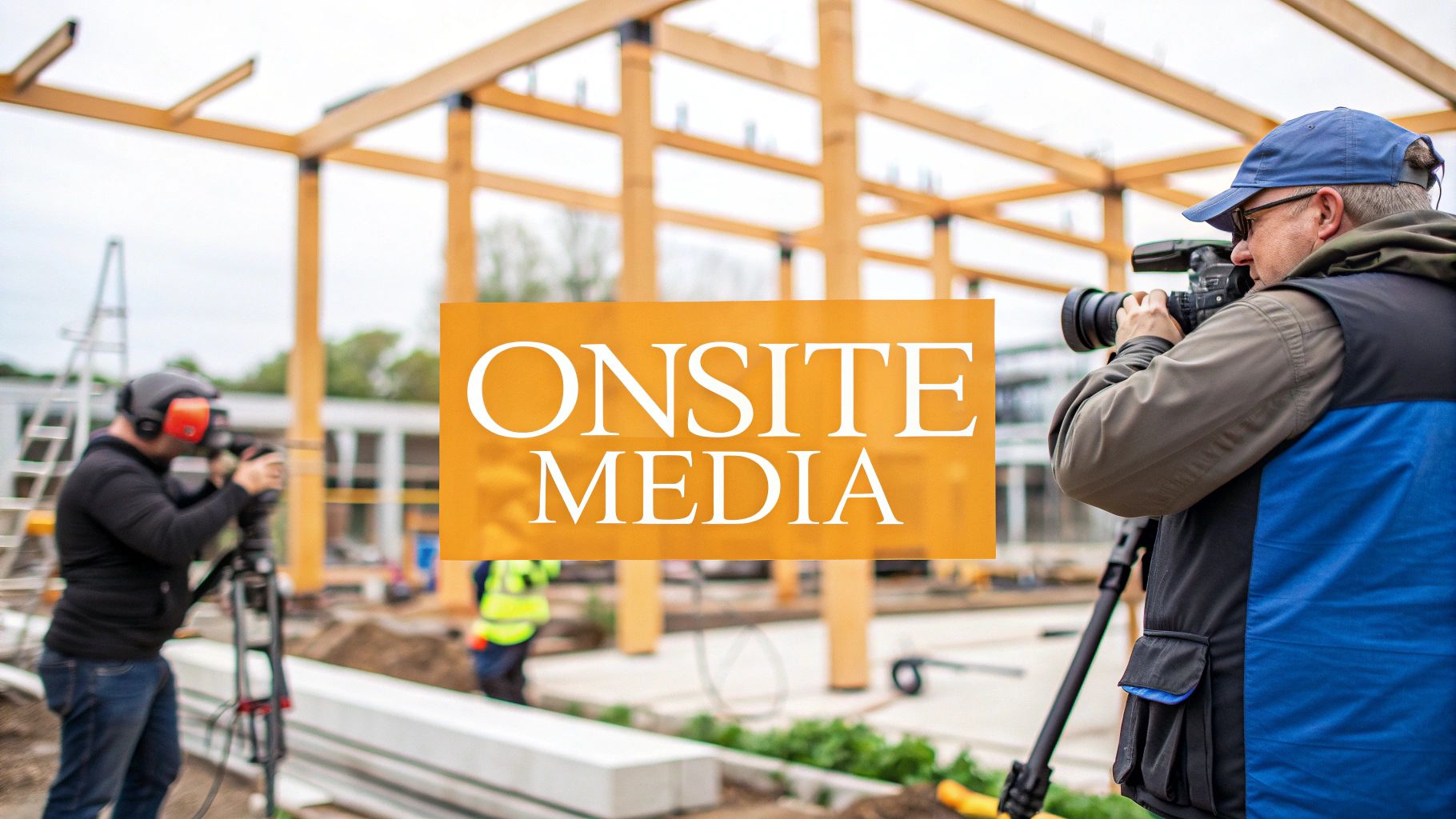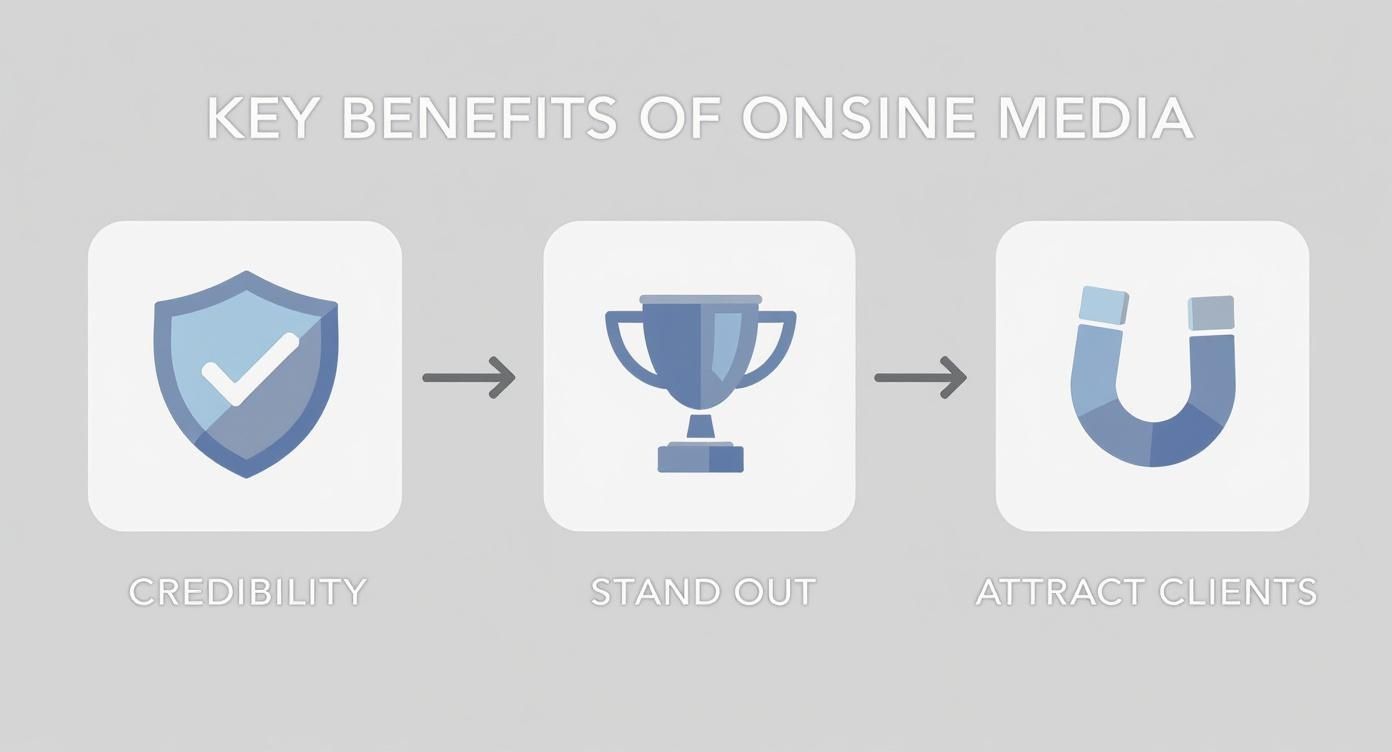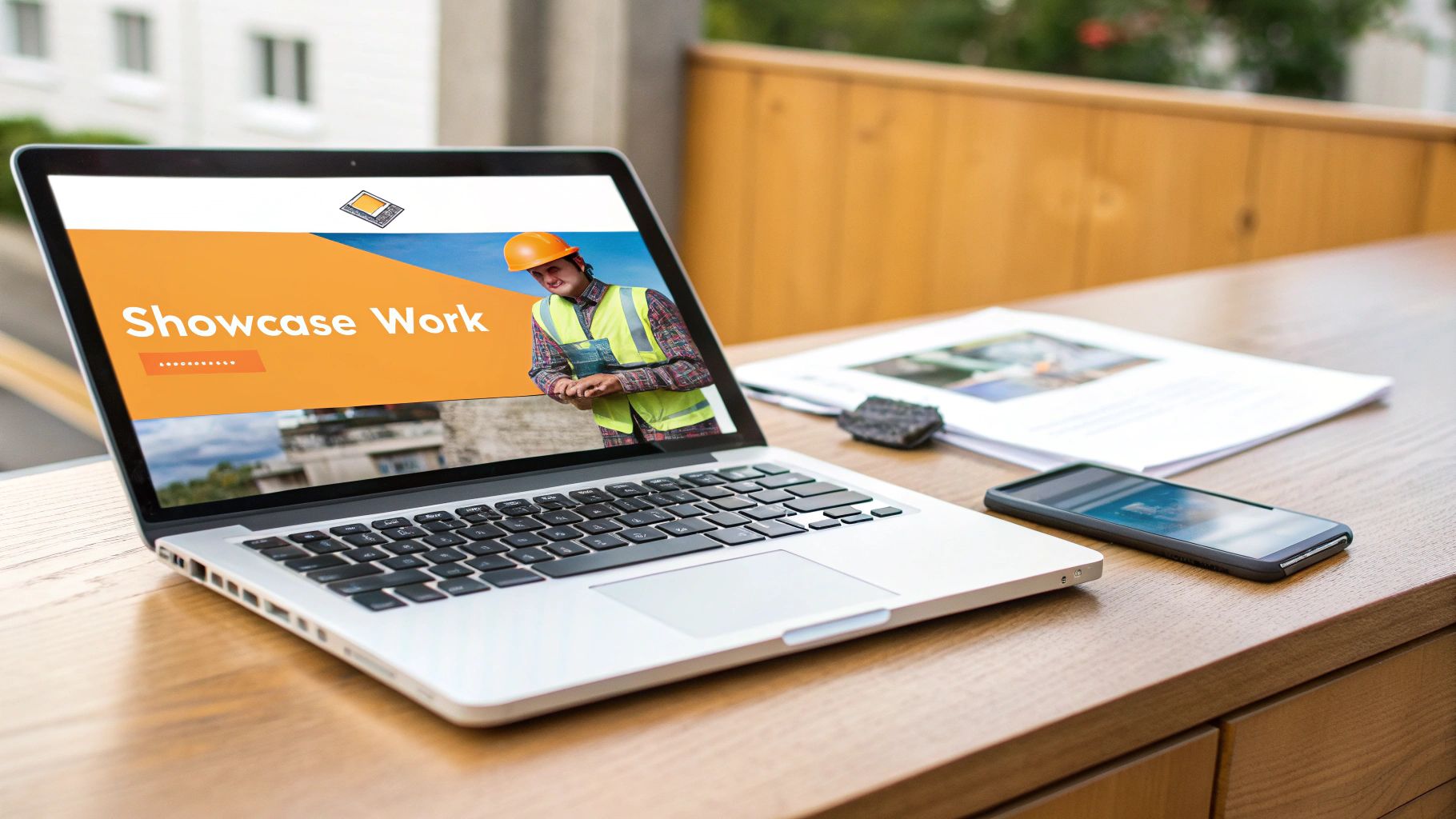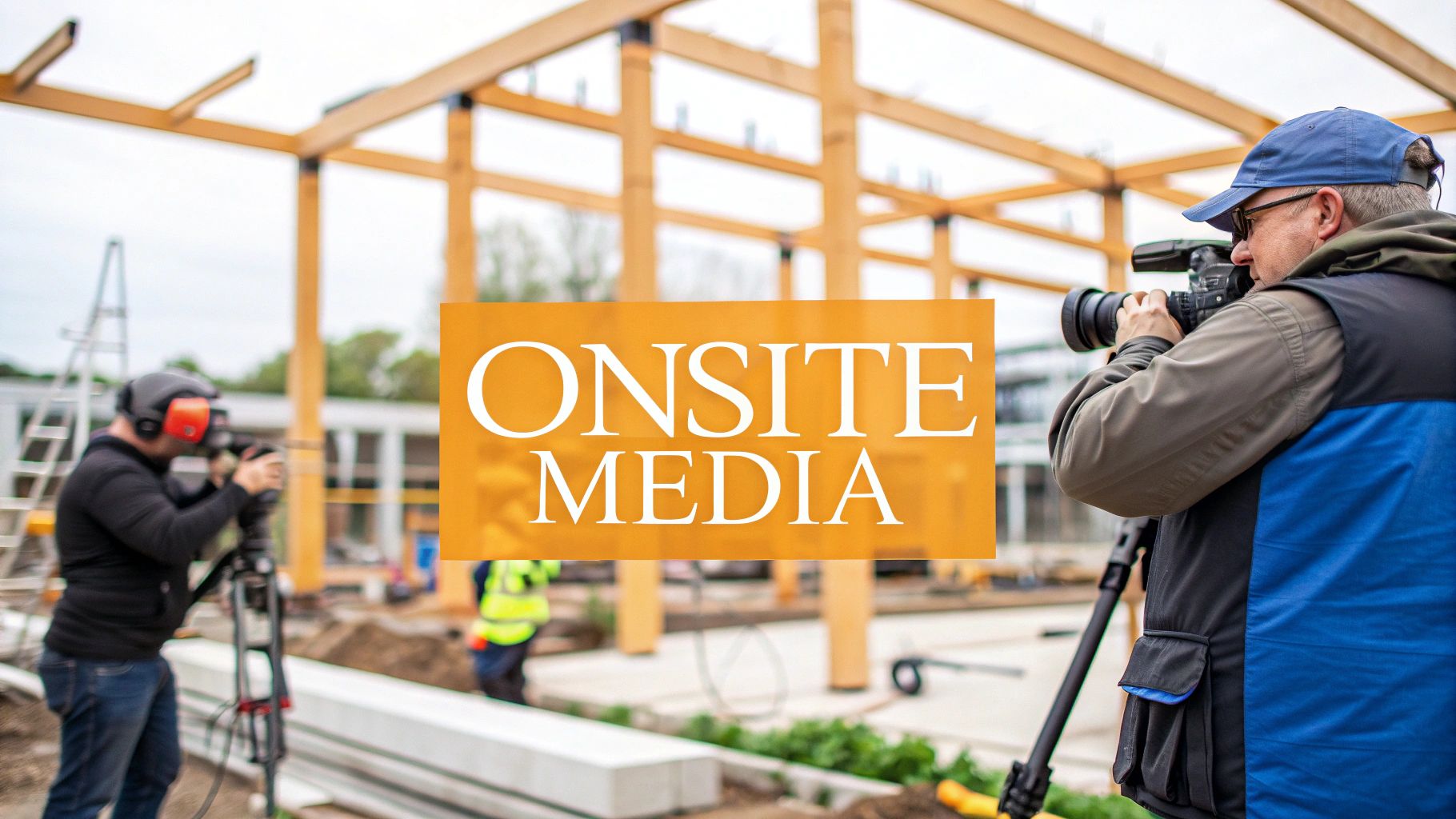


What is onsite media? It's professional photography and video captured right on your job sites. It’s the visual story of your craftsmanship, told through a lens.
This isn't about grabbing a few quick snaps on your phone. It’s about documenting the skill, precision, and hard work that goes into a build long before you hand over the keys. It’s how you prove your quality and win the jobs you really want.
Think about your best project. You know the quality is there—you see it in the straight framing, tidy electrical work, and perfect finishes. But potential clients don't see any of that. They only see what you show them.
If you rely on phone photos, you're letting amateur images define your professional work. That disconnect could be costing you the high-value projects you’re after.
High-quality onsite media closes that gap. It becomes your best salesperson, working 24/7 to prove what you can do. When a potential client compares you to a competitor, a portfolio of sharp, professional images and video gives you the edge. It shifts the conversation from price to quality and trust.
A well-documented project tells a story of professionalism from day one to handover. When you share progress shots of a clean site or close-ups of detailed joinery, you build immediate trust. It shows you’re a builder who cares about the details, not just the final reveal.
This visual proof is more powerful than just telling someone you do good work. It proves your commitment to quality before you even shake their hand. For a client about to invest hundreds of thousands—or millions—of dollars, seeing that level of detail provides serious peace of mind.
Onsite media isn't an expense; it’s an investment in your reputation. It’s the tool that showcases your work at the same high standard you build to, helping you attract clients who will pay for true craftsmanship.
Let's be honest: many builders still use grainy, poorly lit photos taken on their phones. By investing in professional onsite media, you immediately set your brand apart.
Your website, social media, and proposals look more polished. You position yourself as a premium choice in a crowded market. A portfolio filled with stunning visuals shows you operate on another level, helping you attract clients looking for quality, not just a bargain. Whether it’s filming a complex architectural build in Tauranga or photographing a coastal renovation, your media proves your skill and helps you win the work you want.
So, what makes up effective onsite media? It comes down to two key ingredients that work together to tell your project’s story: professional photography and purposeful videography.
Think of these as two sides of the same coin. One captures a powerful moment, while the other brings the process to life. When you get both right, you give potential clients a complete picture of your skill and professionalism. A single visit to a job site can generate a huge amount of marketing material. The trick is knowing what to capture and how each piece will help you win more work.
For builders, professional photography goes beyond snapping a nice picture of the finished home. While those final "hero shots" are essential for your portfolio, the real trust is built with photos taken long before the final coat of paint.
These are your progress and process shots—the images that show the quality hidden behind the GIB.
These behind-the-scenes moments are powerful. They prove your quality is built into the bones of the structure. This is how you show, not just tell, a client that you’re the right choice for their investment.
Video lets you control the story and connect with clients emotionally. But not all videos are created equal. Different formats are designed to achieve specific business goals, turning a casual browser into a solid lead.
A great project video doesn’t just show what you built; it makes the viewer feel what it would be like to live there. It’s your most powerful tool for turning a project into an aspiration for your ideal client.
Think about these key video types:
Here’s a simple breakdown of what each media type achieves.
While a photo proves what you can do, a video helps people understand why they should choose you.
The infographic below shows how these core elements come together to produce real business results.

By focusing on these three outcomes—building credibility, standing out, and attracting clients—your media becomes a strategic asset, not just a collection of pictures.
https://www.youtube.com/embed/Tzr_Xgz6KZA
Investing in professional onsite media isn't just about getting slick photos for your website. It’s a direct strategy for landing bigger and more profitable projects. Your portfolio is your single most powerful sales tool, building trust faster than any conversation could.
When a potential client is considering a huge investment, they’re looking for confidence. They need proof you can deliver on your promises. Professional photos and videos—from a clean foundation pour to the flawless final touches—answer their biggest questions before they even ask.
This is how you shift the conversation from price to value. You stop competing on quotes and start winning on quality.
Treat your onsite media as a visual guarantee of your craftsmanship. Every clean, well-lit image of a tidy worksite or a perfectly executed detail reinforces your professionalism. This isn't just about looking good; it's about building the trust that closes deals.
When a prospect browses a detailed gallery of a complex renovation you handled in Queenstown, they aren't just seeing a finished room. They see evidence of your process, attention to detail, and ability to manage a high-stakes project. This visual proof makes your proposal feel less like a sales pitch and more like a safe bet.
A strong portfolio of onsite media acts as your silent partner in every sales meeting. It backs up every claim you make about quality, making your value tangible and undeniable.
This is the credibility that separates you from the pack. It shows you’re a serious operator who respects the craft and the client's investment.
The media you show the world directly influences the kind of client who calls you. Grainy phone photos attract clients looking for the cheapest price, because that’s the standard you’ve set. Professional, high-end visuals attract clients who appreciate—and will pay for—premium quality.
Your marketing should reflect the standard of your work. By showcasing projects with professional onsite media, you signal to the market that you are a high-calibre builder. This naturally filters out price-shoppers and draws in clients looking for the right partner, not just the lowest bid.
This is a core part of effective builder marketing. To land high-value clients, you must first present a high-value brand. Your project portfolio is on the front line of that effort.
"Why should we choose you?" It’s the question every builder has to answer. Great onsite media gives you a clear, powerful response without you saying a word. When your quote is higher than a competitor's, your portfolio justifies the difference.
You can use your media to walk a client through the unseen value you provide:
These visuals make the abstract concept of "quality" concrete. They prove your price reflects a superior process and a better final product. This turns a pricing discussion into a quality discussion—a conversation you are now equipped to win.
To make sure your onsite media is closing deals, you could explore strategies for Mastering Interactive Video Marketing. It's another way to put your powerful visuals to work and drive real business growth.
A great onsite media shoot doesn't happen by accident. It’s the result of smart planning that respects your time on site and gets the most value from your investment. Get this right, and a potentially disruptive day becomes a smooth process that pays for itself over and over.
The goal is simple: walk away with a library of top-notch photos and videos that will power your marketing for months. Let's break down how to plan your first shoot on an active job site.
Not every job site is ideal for a media shoot. The best projects are the ones that show off the quality you deliver and align with the kind of work you want more of. Look for a build with standout architectural features, high-end finishing, or a tricky problem you solved well.
Timing is everything. You need to capture the site when it looks its best and tells a story about your process.
The best time for an onsite media shoot is when your craftsmanship is most visible. Plan to be there at key milestones to capture the story of quality from the ground up, not just the polished final product.
First impressions count, even in a photo. A clean, organised site looks professional and shows a commitment to safety—exactly the message you want to send. Before the media team arrives, make sure the site is as tidy as possible.
This means sweeping floors, organising tools, and clearing rubbish from the areas you plan to shoot. It’s a small effort that makes a huge difference to the final images.
Briefing your crew is just as important. Give your foreman and the team a heads-up about the shoot. Make sure everyone has the right PPE and is in clean, presentable gear. When your team looks sharp, your company looks sharp.
Your photographer is an expert with a camera, but you're the expert on the build. Don't assume they'll know which details matter most. A simple, clear brief is the key to getting the shots that will actually help your business.
A quick chat and a bullet-point list of "must-have" shots is often all it takes.
Your Onsite Media Shoot Checklist:
This prep ensures the photographer’s time is used well, and you leave with content that genuinely reflects your high standards. For more ideas, our guide to builder content creation offers extra tips on telling your project's story.

Getting great photos and videos is just the first step. The real results come when you put that content to work, turning it into an engine for winning better projects. Your new onsite media shouldn't just sit in a folder; it needs to be out there, proving your worth to potential clients.
This is what turns a pretty picture into a lead-generating asset. The goal is to get the maximum return on your investment, making sure every photo and video helps you look professional, build trust, and grow your business.
Think of your website as your digital storefront. Your portfolio is the star employee who never sleeps. This is where your best onsite media must live, organised into clear, compelling project galleries. When a potential client lands on your site, they need to see undeniable proof of your craftsmanship in seconds.
A strong portfolio does more than just show off finished work. It tells a story.
This approach transforms your website from a brochure into a conversion tool, giving clients the confidence they need to call you.
Think of your content as a library of proof. Every photo and video is a piece of evidence that backs up your claims of quality, making it easier for clients to choose you over a cheaper competitor.
Social media is where you build a community and stay top-of-mind. It’s the perfect place to share your project stories in an engaging way. Your professional onsite media will make your feed stand out, stopping the scroll and drawing people in.
In New Zealand, a strong social presence is crucial. Facebook still dominates, reaching around 3.4 million users. With 75% of New Zealand businesses using a Facebook page, high-quality content gives you a serious advantage.
Use your content to create a narrative around each project. You can find more practical advice in our guide to mastering construction social media. Share a series of posts that follow a build from foundation to handover, showing progress and highlighting your team's expertise.
When you’re bidding for a high-value project, your proposal is often the final hurdle. Including your best onsite media can be the difference between winning and losing. Instead of just describing your quality, show it.
Embed high-resolution images of similar past projects directly into your proposal. This provides tangible proof that you can handle the work you're quoting for. It justifies your pricing and gives the client a clear picture of the premium finish they can expect, making your bid far more compelling than a wall of text.
One of the biggest benefits of a professional shoot is creating a long-term content library. Every photo and video clip becomes a valuable asset you can use for months or even years.
This library gives you a constant supply of material for:
To present empty spaces or future projects in their best light, tools like AI-powered virtual staging can enhance how a client sees the potential. By thinking long-term, you ensure your investment in onsite media pays off for years to come, reinforcing your brand as a leader in quality construction.
Investing in professional onsite media is a smart move, but it’s more than just hiring someone with a good camera. To get a real return, you need to avoid the common mistakes that can turn a valuable asset into a waste of time.
These mistakes can devalue your brand and damage the trust you're trying to build. Getting this right means ensuring every photo and video reflects the high standard of your work. It's about being deliberate and professional—just like you are on the tools.
Here are the key mistakes to avoid so your content works for you.
This is the most common—and most damaging—mistake. A quick phone snap is fine for a client update, but using it for marketing makes your brand look cheap. Poor lighting, crooked angles, and fuzzy resolution can make a high-end build look average.
Potential clients judge your professionalism by what you show them. If your photos look amateur, they'll assume your work might be too. This creates a disconnect between the quality you deliver and the budget image you project online, attracting clients who haggle over price, not value.
Showing up on shoot day without a plan is like starting a build without blueprints. It leads to wasted time, missed opportunities, and a final product that doesn't hit the mark. The photographer won't know which details show your best work or what story you’re trying to tell.
Without a clear brief, you're just taking pictures. With one, you're creating strategic assets designed to win better projects.
A simple plan ensures you capture the shots that matter: the clean framing before GIB goes on, the intricate tile work, or your team working safely. This prep work separates a random collection of photos from a powerful marketing toolkit that proves your expertise.
Your job site is a direct reflection of your company's standards. Simple as that. Capturing it when it’s cluttered with rubbish, disorganised tools, or showing unsafe practices sends a terrible message. A potential client will see a lack of care and assume it carries over into your building work.
Even a perfectly finished project can be undermined by a photo with a messy background. Before any camera comes out, make sure the site is tidy, tools are stored correctly, and your team is in proper PPE.
Presenting a clean, organised, and safe environment in your onsite media is non-negotiable if you want to win high-value contracts. It shows you respect the site, your team, and the client’s investment.
Diving into professional onsite media can feel like a big step. It’s normal to have questions about costs, timing, and other details. We've pulled together the most common ones we hear from builders and answered them straight-up.
This is the big one. While every job is different, it helps to think of it as a slice of the project's marketing value, not its build cost. A good way to frame it is to invest what you'd be happy to spend to land your next ideal project.
For a quality shoot that gives you a solid bank of photos and video clips, you're generally looking at a starting point in the low thousands. Get a clear quote that spells out exactly what's included so you know the full value you're getting.
Don't wait until handover. The real value lies in capturing key milestones to tell a complete story of quality.
Yes, 100%. You must get clear, written permission from the property owner before you use photos or videos of their home in your marketing. Professionally and legally, this is non-negotiable.
Most clients are proud of their new home and are happy to agree, especially if you bring it up early. A simple clause in your contract or a separate release form is the cleanest way to handle it and protect everyone involved.
Ready to make your business look as good online as it does on site? Onsite Media is New Zealand’s specialist content and marketing studio for the construction industry. We help you win better projects.

